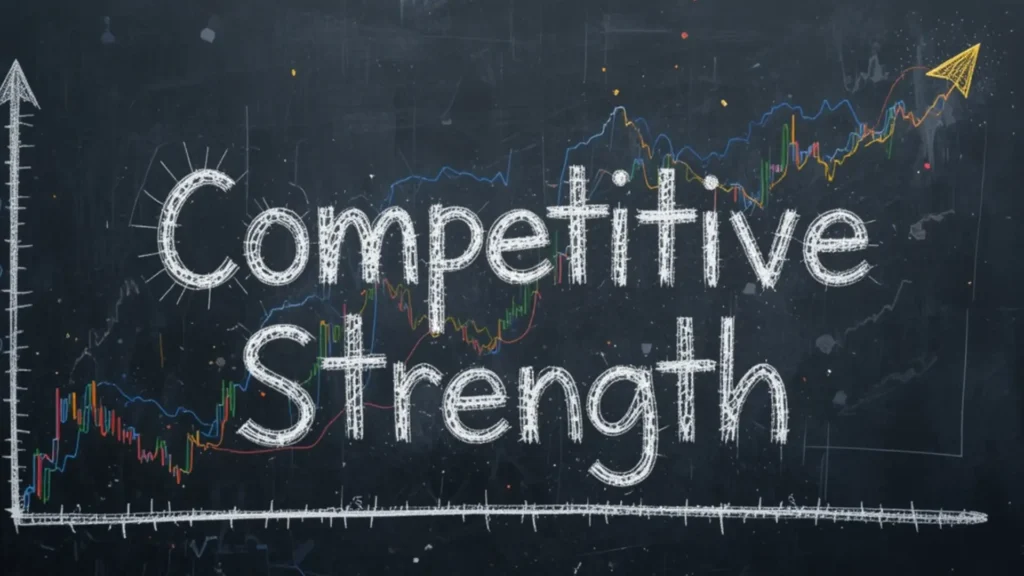When you invest, numbers tell only part of the story. A company may show strong profits one year and struggle the next. Understanding its competitive strength helps you see past short-term results. Strong companies survive tough markets, grow faster, and reward shareholders consistently.
Investors who ignore competitive strength risk buying a company that looks good today but falls apart tomorrow. By knowing how to measure it, you can spot companies that have staying power. This article will guide you step by step. You will learn practical ways to evaluate a company’s edge over its rivals.
The Key Areas to Focus On
Competitive strength is not a single factor. It comes from several sources working together. Each source gives the company an edge over competitors and helps it capture and retain customers. Focusing on only one aspect can give a misleading picture. A company may have a great product but poor management, or low costs but weak customer loyalty. You need to look at the full picture to understand true strength.
Market Position
A company’s market position shows how strong it is in its industry. Large market share gives more influence, resources, and stability. Check trends over time. Is the company gaining share, losing it, or staying the same? A
growing market share signals that the company is winning customers from rivals. Also, look at barriers to entry. Patents, exclusive contracts, and high startup costs make it hard for competitors to challenge the company.
Product Quality and Differentiation
Products and services define how the company is seen by customers. High-quality and unique products attract and retain buyers.
Evaluate product performance compared to competitors. Look for features, benefits, or technology that competitors cannot easily replicate. New product launches or updates show the company is innovating and staying ahead. Strong products reduce risk and support long-term profitability.
Cost Advantages
Cost advantages allow a company to operate efficiently. Companies that produce goods or services at lower costs can survive market pressures better than competitors. Examine production efficiency, supply chain strength, and economies of scale.
A cost advantage lets a company offer lower prices without losing profit, or higher profit margins at the same price. Efficiency is not just cutting costs—it includes smart use of resources, technology, and operational processes.
Customer Loyalty
Customer loyalty is one of the strongest indicators of competitive strength. Loyal customers generate consistent revenue and are harder for competitors to attract. Look at repeat purchase rates, brand recognition, and retention programs.
Companies with loyal customers have more predictable cash flow. Strong brands can also charge higher prices and expand into new markets more easily.
Management Quality
Even the strongest products, loyal customers, and cost advantages cannot guarantee success without capable management.
Leaders shape strategy, make investment decisions, and respond to market changes. Review their track record, strategic decisions, and ability to navigate challenges. Good management turns potential into actual performance. Poor management can destroy advantages quickly.
Each of these areas tells a part of the story. Skipping one could lead to a wrong conclusion. By evaluating all five, you can see whether a company has lasting competitive strength or if its advantages are temporary.
Market Position: Where the Company Stands
Market position shows how strong a company is in its industry and how well it competes with rivals. Companies with a larger market share have more influence, resources, and stability than smaller competitors.
Market position is not just about size—it also shows momentum. You want to know whether the company is gaining ground, losing it, or maintaining its status.
Key Metrics to Examine
- Market share over time: Track how the company’s share changes. Steady growth indicates it attracts more customers than competitors. A falling share suggests rivals are taking business, signaling potential weaknesses.
- Sales growth compared to competitors: Compare growth rates within the same industry. Higher growth than peers shows the company is outperforming. Slower growth may indicate stagnation or declining relevance.
- Industry trends: Understand whether the company operates in a growing, stable, or shrinking market. Even a strong company may face pressure in a declining sector. Companies in growing industries have more opportunities to expand market share.
Strong companies often protect their position by creating obstacles for new competitors. High barriers to entry reduce the risk of losing market share. Look for factors such as:
- Patents or proprietary technology that competitors cannot copy easily.
- Exclusive supplier or distribution contracts that limit access for newcomers.
- High startup costs in production, marketing, or infrastructure that make entering the market difficult.
A company with strong barriers can maintain profits longer, even if new competitors appear. Checking both market share trends and barriers to entry gives you a clear picture of how strong the company’s position truly is.
Product Quality and Differentiation
Products and services define how a company is seen by customers. High-quality, reliable, and unique offerings attract buyers and create loyalty.
A company with strong products can defend its market share, command better prices, and maintain stable revenue. Assessing product quality and differentiation is essential to understand a company’s competitive strength.
Key Factors to Evaluate
- Product performance versus competitors: Compare features, reliability, and overall quality. A product that consistently outperforms rivals strengthens the company’s reputation and customer base.
- Unique features or benefits: Identify what sets the product apart. Unique benefits, specialized technology, or proprietary processes make it harder for competitors to replicate success.
- Customer reviews and feedback: Listen to real users. Positive reviews, high satisfaction scores, and low return rates indicate that the company meets customer needs effectively.
Differentiation allows the company to charge higher prices or retain customers longer. If competitors struggle to copy the product, the company gains a lasting advantage. Watch for product updates, new launches, or improvements.
These signals show that the company invests in innovation and maintains relevance in a competitive market.
Track product launches, patents, and innovations over the past few years. A company that consistently improves or expands its offerings is likely to sustain growth. Strong product lines reduce risk and support long-term profits, giving investors confidence in future performance.
Cost Advantage and Efficiency
A company’s cost structure directly affects its profitability and resilience. Companies that produce goods or services at lower cost can survive price cuts, economic slowdowns, or competitive pressure better than rivals. Cost advantage is a key pillar of competitive strength because it provides flexibility and stability.
Key Factors to Evaluate
- Production efficiency: Assess how effectively the company converts raw materials and labor into finished products. High efficiency reduces waste and lowers overall costs.
- Supply chain strength: A strong, reliable supply chain prevents disruptions and reduces operational costs. Companies with solid supplier relationships can secure materials at better prices.
- Economies of scale: Large companies often produce at lower per-unit costs due to volume. This allows them to offer competitive prices while maintaining higher margins.
A company with a cost advantage can do one of two things: charge lower prices to gain market share, or maintain higher margins while keeping prices competitive. Both strategies improve profitability. Compare the company’s unit costs with competitors. Lower costs indicate an edge that rivals may struggle to match.
Efficiency is not just about spending less. Smart allocation of resources, effective technology adoption, and streamlined operations all add to a company’s competitive strength. Efficient companies can respond faster to market changes, invest in growth initiatives, and sustain profits during downturns.
Look at gross margins, operating margins, and cost per unit over several years. Consistently lower costs and higher margins than competitors indicate a sustainable advantage. Companies that manage costs efficiently tend to be more resilient and profitable over the long term.
Customer Loyalty and Brand Strength
Customer loyalty is one of the strongest indicators of a company’s competitive strength. Companies with loyal customers face lower risk of revenue loss and can maintain stable cash flow even in tough market conditions. Loyal customers return repeatedly, recommend the brand to others, and are less sensitive to price changes.
Key Metrics to Track
- Repeat purchase rates: Track how often customers return. High repeat rates indicate satisfaction and trust in the product or service.
- Brand recognition and trust: Evaluate public perception through surveys, social media sentiment, or brand rankings. Strong recognition and trust create a psychological edge over competitors.
- Subscription or membership programs: Programs that lock in customers for extended periods are strong loyalty indicators. They provide predictable revenue and strengthen the customer relationship.
Loyal customers are harder for competitors to take. They reduce marketing costs and increase lifetime value per customer. Monitoring retention over time reveals trends in loyalty. Growing retention rates indicate that the company has built a sustainable competitive moat.
Brand value extends beyond customer loyalty. A trusted brand can command higher prices, launch new products successfully, and expand into new markets with lower risk. Strong brands indicate durability, operational competence, and a reputation that competitors cannot easily copy.
Look at customer retention rates, net promoter scores, and brand rankings over several years. Companies that maintain or grow loyalty have a strong foundation for long-term profitability. High loyalty combined with strong brand value signals a company capable of withstanding competitive pressures and market changes.
Management and Strategic Execution
Strong management transforms competitive potential into real results. Even a company with excellent products, loyal customers, and low costs can fail under poor leadership. Executives’ decisions influence growth, efficiency, risk management, and overall sustainability. Evaluating management is crucial to understanding whether a company can maintain and strengthen its competitive advantages.
Key Factors to Evaluate
- Track record of executives: Examine past performance of key leaders. Have they consistently delivered growth, profitability, and market share gains? Leaders with a strong track record indicate reliability and competence.
- Quality of strategic decisions: Analyze major initiatives, such as acquisitions, expansions, or product launches. Sound strategic choices often create long-term value. Poor decisions can quickly erode competitive advantages, even in strong companies.
- Response to market changes: Observe how management adapts to competition, economic shifts, or technological changes. Companies that respond proactively and strategically tend to sustain growth, while reactive companies may fall behind.
Good management invests wisely in products, people, and technology. They balance short-term results with long-term growth. Leaders with long-term thinking focus on innovation, efficiency, and customer retention. Poor leadership can destroy advantages built over years, regardless of a company’s other strengths.
Look for consistency between strategy, execution, and results over time. Review investor letters, annual reports, and public statements. Management teams that consistently achieve objectives and respond effectively to challenges signal sustainable competitive strength.
Analyzing competitive strength is not about one number or metric. It is about a combination of market position, product quality, cost advantage, customer loyalty, and management. Each element supports the others. Strong companies show strength across multiple areas.
Investors who assess these factors can identify companies likely to grow and survive challenges. The payoff is higher confidence and better investment decisions. By looking beyond profits, you see durability and future potential.
Competitive strength explains why some companies thrive and others fail. By examining market position, products, costs, customer loyalty, and management, you can spot companies with long-term advantages.
This knowledge reduces risk and increases your chances of success. It lets you invest in companies that can endure competition, adapt to change, and generate lasting profits. Understanding competitive strength is a key step in becoming a smarter, more strategic investor.




